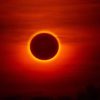X-class solar flares are the most intense type of solar flare, with their strength rated from 1 to 9, where 9 represents the highest level of intensity. The most recent X-class flare, classified as X1.3, originated from sunspot region AR3777. This flare peaked at 3:35 p.m. EDT (1935 UTC) and is the most powerful observed from this active region to date.
The flare was accompanied by a coronal mass ejection (CME) that traveled at a remarkable speed of over 2.2 million mph (1,000 km/s). CMEs are known for their high velocities and can impact space weather significantly. The eruption caused widespread shortwave radio disruptions, resulting in a blackout that affected North America and the Hawaiian Islands, as noted by NOAA.

In response to this activity, a geomagnetic storm watch is in place through Sunday, August 11, due to the forecasted arrival of three CMEs. The anticipated solar storm is currently projected to be a G2 (Moderate) level, but scientists are keeping a close watch to assess the exact impacts as the CMEs approach Earth.
The increased geomagnetic activity may create opportunities for aurora viewing in the northern and upper Midwest, spanning areas from New York to Idaho. However, the visibility of these auroras will be influenced by local weather conditions.

